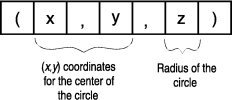The SQL opaque data type
An opaque data type is a user-defined data type that can be used in the same way as the HCL OneDB™ built-in data types. The opaque data type allows you to define new data types for your database applications.
An opaque data type is fully encapsulated; the database server does not know about the internal format of an opaque data type. Therefore, the database server cannot make assumptions about how to access a column having an opaque data type. The database developer defines a data structure that holds the opaque-type information and support functions that tell the database server how to access this data structure.
For more information about how to create an opaque data type, see the description of the CREATE OPAQUE TYPE statement in the HCL OneDB Guide to SQL: Syntax and in HCL OneDB User-Defined Routines and Data Types Developer's Guide.
- In the external format, as a character string
Transfer of the external format between the client application and database server is supported by the database server through the input and output support functions of the opaque data type.
- In the internal format, as a data structure in an external programming
language (such as C)
Transfer of the internal format between the client application and database server is supported by the database server through the receive and send support functions of the opaque data type.
- HCL OneDB data type
- ESQL/C host variable
- External format of an opaque data type
- lvarchar host variable
- Internal format of an opaque data type
- fixed binary host variable
var binary host variable
typedef struct
{
double x;
double y;
} point_t;
typedef struct
{
point_t center;
double radius;
} circle_t;CREATE OPAQUE TYPE circle (INTERNALLENGTH = 24,
ALIGNMENT = 4);
CREATE FUNCTION circle_in(c_in lvarchar) RETURNS circle
EXTERNAL NAME '/usr/lib/circle.so(circle_input)'
LANGUAGE C;
CREATE IMPLICIT CAST (lvarchar AS circle WITH circle_in);
CREATE FUNCTION circle_out(c_out circle) RETURNS lvarchar
EXTERNAL NAME '/usr/lib/circle.so(circle_output)'
LANGUAGE C;
CREATE IMPLICIT CAST (circle AS lvarchar WITH circle_out);
CREATE FUNCTION circle_rcv(c_rcv sendrcv) RETURNS circle
EXTERNAL NAME '/usr/lib/circle.so(circle_receive)'
LANGUAGE C;
CREATE IMPLICIT CAST (sendrcv AS circle WITH circle_rcv);
CREATE FUNCTION circle_snd(c_snd circle) RETURNS sendrcv
EXTERNAL NAME '/usr/lib/circle.so(circle_send)'
LANGUAGE C;
CREATE IMPLICIT CAST (circle AS sendrcv WITH circle_snd);
CREATE FUNCTION radius(circle) RETURNS FLOAT
EXTERNAL NAME '/usr/lib/circle.so'
LANGUAGE C;
CREATE TABLE circle_tab (circle_col circle);
INSERT INTO circle_tab VALUES ('(12.00, 16.00, 13.00)');
INSERT INTO circle_tab VALUES ('(6.5, 8.0, 9.0)');